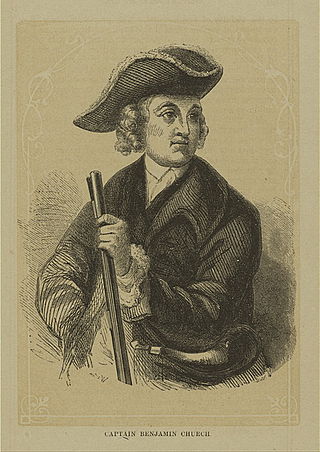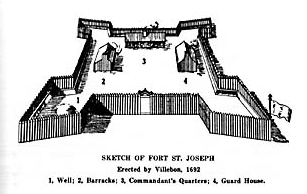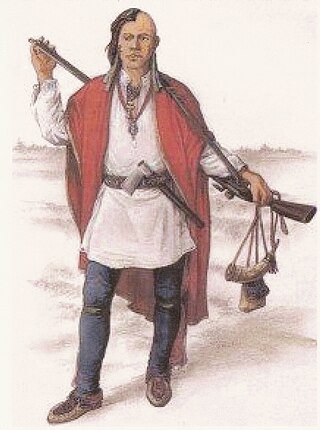Related Research Articles

Acadia was a colony of New France in northeastern North America which included parts of what are now the Maritime provinces, the Gaspé Peninsula and Maine to the Kennebec River.
The history of Fredericton stretches from prehistory to the modern day. Fredericton, New Brunswick was first inhabited by the Mi'kmaq and Maliseet peoples. European settlement of the area began with the construction of Fort Nashwaak by the French in 1692. In 1783, the United Empire Loyalists settled Ste. Anne's Point, and in the next year, renamed the settlement Frederick's Town. The name was later shorted to Fredericton in April 1785.

The Battle of Port Royal occurred at Port Royal, the capital of Acadia, during King William's War. A large force of New England provincial militia arrived before Port Royal. The Governor of Acadia Louis-Alexandre des Friches de Menneval had only 70 soldiers; the unfinished enceinte remained open and its 18 cannon had not been brought into firing positions; 42 young men of Port-Royal were absent. Any resistance therefore appeared useless. Meneval surrendered without resistance not long after the New Englanders arrived. The New Englanders, led by Sir William Phips, after alleging Acadian violations of the terms of surrender, plundered the town and the fort.
Joseph Robineau de Villebon, a governor of Acadia, was born in New France and received much of his education and military experience in France.
David Basset was a merchant active in Newfoundland and New England. He was French born Huguenot.
Claude-Sébastien de Villieu was a French military officer best known for his service in New France. In addition to service during King William's War, he served for a time as military governor of Acadia.

The St. John River campaign occurred during the French and Indian War when Colonel Robert Monckton led a force of 1150 British soldiers to destroy the Acadian settlements along the banks of the Saint John River until they reached the largest village of Sainte-Anne des Pays-Bas in February 1759. Monckton was accompanied by Captain George Scott as well as New England Rangers led by Joseph Goreham, Captain Benoni Danks, as well as William Stark and Moses Hazen, both of Rogers' Rangers.

John Gyles was an interpreter and soldier, most known for his account of his experiences with the Maliseet tribes at their headquarters at Meductic, on the Saint John River.

The Raid on Chignecto occurred during King William's War when New England forces from Boston attacked the Isthmus of Chignecto, Acadia in present-day Nova Scotia. The raid was in retaliation for the French and Indian Siege of Pemaquid (1696) at present day Bristol, Maine. In the English Province of Massachusetts Bay. Colonel Benjamin Church was the leader of the New England force of 400 men. The raid lasted nine days, between September 20–29, 1696, and formed part of a larger expedition by Church against a number of other Acadian communities.

The Siege of Pemaquid occurred during King William's War when French and Native forces from New France attacked the English settlement at Pemaquid, a community on the border with Acadia. The siege was led by Pierre Le Moyne d'Iberville and Baron de St Castin between August 14–15, 1696. Commander of Fort William Henry, Captain Pasco Chubb, surrendered the fort. Iberville killed three of the soldiers and sent the other 92 back to Boston.

The Naval battle off St. John took place on July 14, 1696, between France and England toward the end of King William's War in the Bay of Fundy off present-day Saint John, New Brunswick. The English ships were sent from Boston to interrupt the supplies being taken by French officer Pierre Le Moyne d'Iberville from Quebec to the capital of Acadia, Fort Nashwaak on the Saint John River. The French ships of war Envieux and Profond captured the English frigate Newport, while the English frigate Sorlings and a provincial tender escaped.

The Battle of Chedabucto occurred against Fort St. Louis in Chedabucto on June 3, 1690, during King William's War (1689–97). The battle was part of Sir William Phips and New England's military campaign against Acadia. New England sent an overwhelming force to conquer Acadia by capturing the capital Port Royal, Chedabucto, and attacking other villages. The aftermath of these battles was unlike any of the previous military campaigns against Acadia. The violence of the attacks alienated many of the Acadians from the New Englanders, broke their trust, and made it difficult for them to deal amicably with the English-speakers.

The siege of Fort Nashwaak occurred during King William's War when New England forces from Boston attacked the capital of Acadia, Fort Nashwaak, at present-day Fredericton, New Brunswick. The siege was in retaliation for the French and Indian Siege of Pemaquid (1696) at present day Bristol, Maine. In the English Province of Massachusetts Bay. Colonel John Hathorne and Major Benjamin Church were the leaders of the New England force of 400 men. The siege lasted two days, between October 18–20, 1696, and formed part of a larger expedition by Church against a number of other Acadian communities.

Nova Scotia is a Canadian province located in Canada's Maritimes. The region was initially occupied by Mi'kmaq. The colonial history of Nova Scotia includes the present-day Maritime Provinces and the northern part of Maine, all of which were at one time part of Nova Scotia. In 1763, Cape Breton Island and St. John's Island became part of Nova Scotia. In 1769, St. John's Island became a separate colony. Nova Scotia included present-day New Brunswick until that province was established in 1784. During the first 150 years of European settlement, the colony was primarily made up of Catholic Acadians, Maliseet, and Mi'kmaq. During the last 75 years of this time period, there were six colonial wars that took place in Nova Scotia. After agreeing to several peace treaties, the long period of warfare ended with the Halifax Treaties (1761) and two years later, when the British defeated the French in North America (1763). During those wars, the Acadians, Mi'kmaq and Maliseet from the region fought to protect the border of Acadia from New England. They fought the war on two fronts: the southern border of Acadia, which New France defined as the Kennebec River in southern Maine, and in Nova Scotia, which involved preventing New Englanders from taking the capital of Acadia, Port Royal and establishing themselves at Canso.

Fort Nashwaak was the capital of Acadia and is now a National Historic Site of Canada in present-day Fredericton, New Brunswick, Canada. It was located strategically up the Saint John River and close to the native village of Fort Meductic for military purposes.

Port Royal (1605–1713) was a historic settlement based around the upper Annapolis Basin in Nova Scotia, Canada, and the predecessor of the modern town of Annapolis Royal.

The military history of the Mi'kmaq consisted primarily of Mi'kmaq warriors (smáknisk) who participated in wars against the English independently as well as in coordination with the Acadian militia and French royal forces. The Mi'kmaq militias remained an effective force for over 75 years before the Halifax Treaties were signed (1760–1761). In the nineteenth century, the Mi'kmaq "boasted" that, in their contest with the British, the Mi'kmaq "killed more men than they lost". In 1753, Charles Morris stated that the Mi'kmaq have the advantage of "no settlement or place of abode, but wandering from place to place in unknown and, therefore, inaccessible woods, is so great that it has hitherto rendered all attempts to surprise them ineffectual". Leadership on both sides of the conflict employed standard colonial warfare, which included scalping non-combatants. After some engagements against the British during the American Revolutionary War, the militias were dormant throughout the nineteenth century, while the Mi'kmaq people used diplomatic efforts to have the local authorities honour the treaties. After confederation, Mi'kmaq warriors eventually joined Canada's war efforts in World War I and World War II. The most well-known colonial leaders of these militias were Chief (Sakamaw) Jean-Baptiste Cope and Chief Étienne Bâtard.

The military history of the Acadians consisted primarily of militias made up of Acadian settlers who participated in wars against the English in coordination with the Wabanaki Confederacy and French royal forces. A number of Acadians provided military intelligence, sanctuary, and logistical support to the various resistance movements against British rule in Acadia, while other Acadians remained neutral in the contest between the Franco–Wabanaki Confederacy forces and the British. The Acadian militias managed to maintain an effective resistance movement for more than 75 years and through six wars before their eventual demise. According to Acadian historian Maurice Basque, the story of Evangeline continues to influence historic accounts of the expulsion, emphasising Acadians who remained neutral and de-emphasising those who joined resistance movements. While Acadian militias were briefly active during the American Revolutionary War, the militias were dormant throughout the nineteenth century. After confederation, Acadians eventually joined the Canadian War efforts in World War I and World War II. The most well-known colonial leaders of these militias were Joseph Broussard and Joseph-Nicolas Gautier.

The Maliseet militia was made up of warriors from the Maliseet of northeastern North America. Along with the Wabanaki Confederacy, the French and Acadian militia, the Maliseet fought the British through six wars over a period of 75 years. They also mobilized against the British in the American Revolution. After confederation, Maliseet warriors eventually joined Canada's war efforts in World War I and World War II.
Simon-Gérard de La Place was a 17th-century French priest and missionary who served in Acadia, the French province in what is modern north-eastern Canada. He participated in King William's War against English-led forces in Acadia.
References
- Endnotes
- ↑ Baptiste married an Acadian woman in Port Royal (c.1693). He seems to have already had a child with a woman in France, both of whom he brought from France to Acadia three years later (1696). His wife, Judith Soubiron, after giving birth in Acadia to two children, Pierre and Jean, died in Port Royal on Oct. 19, 1703, while Baptiste was imprisoned in Boston. Upon his return from Boston, on January 12, 1707, Baptiste remarried, this time a widow, Marguerite Bourgeois, born in Port Royal, the daughter of Jacques Bourgeois, first of the name in Acadia.
- ↑ (Roger Marsters. 2004.p.28)
- ↑ Clarence d'Entremont. Baptiste the Rascal. Yarmouth Vanguard. March 7, 1989.
- ↑ (Roger Marsters. 2004.p.30)
- ↑ After the Battle of Port Royal (1690), governor of Acadia, Joseph Robineau de Villebon moved the capital of Acadia from Port Royal to Fort Nashwaak (also known as Fort St. Joseph) at present day Fredericton, New Brunswick (1692). Initially the Capital was moved from Port Royal to Jemseg, New Brunswick at Fort Jemseg (1690) before moving to Fredericton the following year.
- ↑ (Roger Marsters. 2004.p.3)
- ↑ (Roger Marsters. 2004.p.32)
- ↑ (Roger Marsters. 2004.p.32-33)
- ↑ Webster, John Clarence. Acadia at the End of the Seventeenth Century. Saint John, NB, The New Brunswick Museum, 1979. p. 161.
- ↑ (Roger Marsters. 2004.p.33)
- ↑ near where the Fort Nashwaak Motel now stands
- ↑ For details on the Siege see Beamish Murdoch, pp. 228-231
- ↑ (Roger Marsters. 2004.p.34)
- ↑ (Roger Marsters. 2004.p.35)
- ↑ (Roger Marsters. 2004.p.35)
- ↑ Murdoch, (p. 243)
- ↑ Murdoch, p.255
- ↑ Murdoch, p. 279
- ↑ (Roger Marsters. 2004. p.36)
- ↑ (Roger Marsters. 2004.p.36)
- ↑ Squires, W. Austin (1979) [1969]. "Guion, François". In Hayne, David (ed.). Dictionary of Canadian Biography . Vol. II (1701–1740) (online ed.). University of Toronto Press.
- Secondary Sources
- Squires, W. Austin (1979) [1969]. "Maisonnat, Baptiste, Pierre". In Hayne, David (ed.). Dictionary of Canadian Biography . Vol. II (1701–1740) (online ed.). University of Toronto Press.
- Roger Marsters. 2004. "[Baptiste:] A Corsiar on the Border." Bold Privateers: Terror, Plunder and Profit on Canada's Atlantic Coast. pp. 25–36
- "Baptiste was said to have a wife in every port" Yarmouth Vanguard, March 14, 1989
- Murdoch, Beamish (1866). A History of Nova-Scotia, Or Acadie. Vol. II. Halifax: J. Barnes. p. 215.
- John Clarence Webster. Acadia at the End of the Seventeenth Century. Saint John, NB, The New Brunswick Museum, 1979.